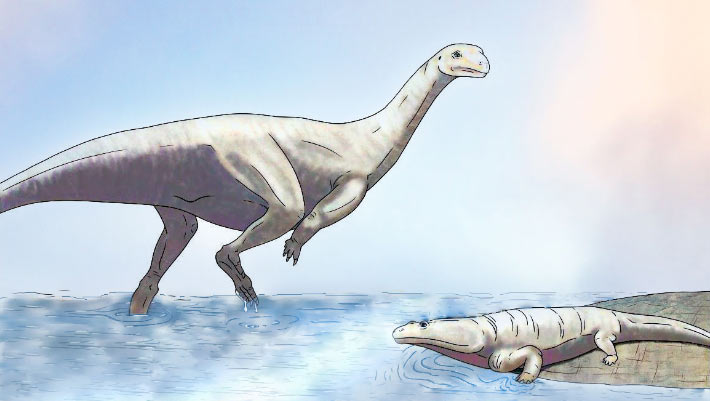A new genus and species of massopodan sauropodomorph dinosaur has been identified form the fossilized remains found on the shoreline of Lake Kariba, Zimbabwe.
An artist’s impression of Musankwa sanyatiensis, walking in Triassic shallow waters past a metoposaur. Image credit: Atashni Moopen / Sci.News.
The newly-described species lived in Africa during the Late Triassic epoch, approximately 210 million years ago.
Named Musankwa sanyatiensis, the dinosaur is estimated to have reached a height of about 1.5 m at the hip and a weight of 390 kg.
It belongs to Massopoda, a group of sauropodomorph dinosaurs that lived during the Late Triassic to Late Cretaceous epochs.
“Our evolutionary trees hinted that the new species might be linked to Riojasaurus from Argentina and Eucnemesaurus from South Africa,” said Professor Paul Barrett from the Natural History Museum in London and her colleagues.
“This may mean these animals were a widespread group of dinosaurs able to move back and forth between what is now South America and southern Africa.”
“This particular species dates back to the Late Triassic when dinosaurs were getting larger and starting to dominate ecosystems.”
“At this time, they began to become more diverse and spread around the world, making it an important era to investigate.”
The paleontologists found the remains of Musankwa sanyatiensis — a single hind leg, including its thigh, shin, and ankle bones — at the Spurwing East Palaeosol site of the Pebbly Arkose Formation, situated on the north-eastern shoreline of Spurwing Island, Lake Kariba, Mid-Zambezi Basin, Zimbabwe.
The new species is only the fourth dinosaur to be named from the Karoo-aged basins of Zimbabwe.
It is also the first to be named from the Mid-Zambezi Basin in over 50 years.
“Over the last six years, many new fossil sites have been recorded in Zimbabwe, yielding a diverse array of prehistoric animals, including the first sub-Saharan mainland African phytosaurs (ancient crocodile-like reptiles), metoposaurid amphibians (giant armored amphibians), lungfish, and other reptile remains,” Professor Barrett said.
“The main reason for the underrepresentation of African dinosaur fossils is ‘undersampling’,” said Dr. Kimberley Chapelle, a paleontologist at Stonybrook University and the University of the Witwatersrand.
“Put simply, there have been fewer people looking for and unearthing dinosaurs in comparison with other regions of the world.”
“Based on where it sits on the dinosaur family tree, Musanwka sanyantiensis is the first dinosaur of its kind from Zimbabwe.”
“It therefore highlights the potential of the region for further paleontological discoveries.”
The discovery of Musankwa sanyatiensis is reported in a paper in the journal Acta Palaeontologica Polonica.
_____
Paul M. Barrett et al. 2024. A new Late Triassic sauropodomorph dinosaur from the Mid-Zambezi Basin, Zimbabwe. Acta Palaeontologica Polonica 69 (2): 227-241; doi: 10.4202/app.01100.2023
>>> Read full article>>>
Copyright for syndicated content belongs to the linked Source : Breaking Science News – https://www.sci.news/paleontology/musanwka-sanyantiensis-12979.html
